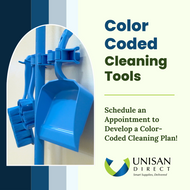8th Apr 2024
Implementing a color-coded cleaning plan in food processing and food service involves several steps to ensure effectiveness. Here's a general outline of how a company could design and implement a Color Coded Cleaning Plan:
1. Identify Areas and Equipment: Begin by identifying the various areas and equipment that require cleaning within the facility. This might include work surfaces, utensils, machinery, storage areas, etc.
2. Understand Contamination Risks: Assess the risks of cross-contamination in each area. Different areas may have different levels of contamination risk depending on the type of food being processed or served.
3. Select Colors: Choose colors to represent different cleaning tasks or areas. Common colors used in color-coded cleaning plans include red, blue, green, and yellow. Assign specific colors to different areas or tasks based on the contamination risks identified.
4. Develop Training Materials: Create training materials, including visual aids and written instructions, to educate staff on the color-coded cleaning system. Ensure that all staff members understand the importance of the system and know how to properly implement it.
5. Implement Procedures: Develop standard operating procedures (SOPs) for cleaning tasks in each area, specifying which cleaning tools and products should be used for each color-coded zone. Clearly outline the steps to follow for cleaning and sanitizing equipment and surfaces.
6. Provide Equipment: Supply the necessary cleaning equipment and tools in each color-coded zone. This might include brushes, cloths, buckets, gloves, and cleaning solutions. Ensure that there are enough supplies available for staff to perform their cleaning tasks effectively.
7. Monitor Compliance: Regularly monitor staff compliance with the color-coded cleaning plan. This can be done through visual inspections, spot checks, or employee feedback. Provide feedback and additional training as needed to reinforce adherence to the system.
8. Review and Update: Periodically review the color-coded cleaning plan to ensure it remains effective and up to date. Adjust as necessary based on changes in processes, equipment, or regulations.
9. Document Procedures: Document all cleaning procedures and color-coding assignments in a written cleaning plan or manual. Make this information easily accessible to staff for reference.
10. Train New Staff: Incorporate training on the color-coded cleaning system into the onboarding process for new employees. Ensure that all new staff members understand their roles and responsibilities regarding cleaning and hygiene .
By following these steps, a company can effectively design and implement a color-coded cleaning plan to minimize cross-contamination and increase hygiene in food processing and food service environments.
Meet with Unisan Direct's Color Coded Tools Specialist! Schedule an Appointment Today!
Get a Color-Coded Cleaning Consultation!
